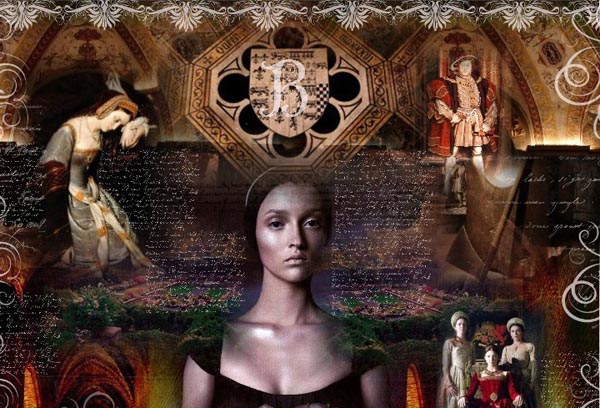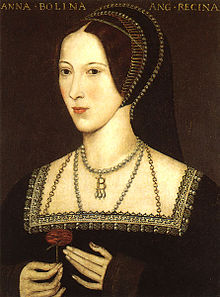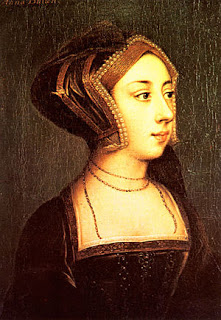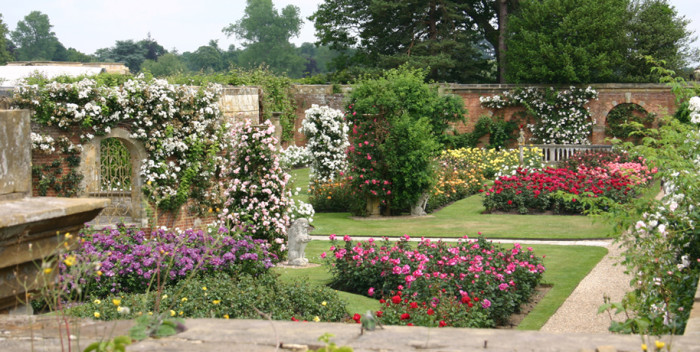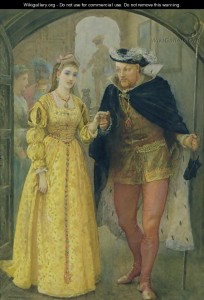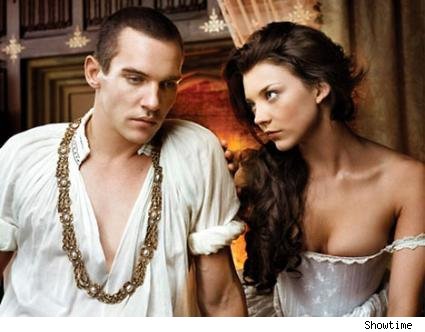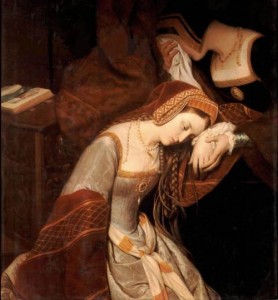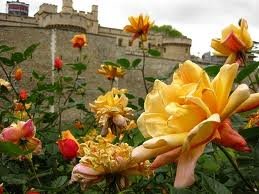Anne of a Thousand Faces
To still be newsworthy some 500 years after your death is no mean feat. Yet something about her continues to ignite imagination across centuries: Anne Boleyn, the woman who set in motion the Protestant Reformation in England, mother of Elizabeth I, and muse to countless composers, painters and authors, is still being talked, written, and wondered about. Howard Brenton’s drama, Anne Boleyn, premiered recently at the Globe Theatre in London, and a few weeks ago, Susan Bordo’s book-long inquiry into why Anne continues to fascinate hit the book shelves. Despite the myriad cinematic and literary depictions – everything from a Donizetti opera to the sexed-up glamour girl of The Tudors, not a single definitive likeness of her exists. Anne Boleyn remains as elusive a quarry as the poetic deer she likely inspired in Thomas Wyatt’s great sonnet, “Whoso List to Hunt.”
Anne Boleyn the most famous "Non-Blonde" (with apologies to Gaia Fishler of The Non Blonde Perfume Blog)
What do we know for certain? The dark-eyed, raven-haired Anne Boleyn caused quite a stir across Europe when Henry VIII broke with the Catholic Church in Rome to marry her. But it was also the force of her personality that made her a cause célèbre. Anne was outspoken at a time when women held their tongues, was ‘brunet’ when blonde and fair was considered the epitome of female beauty, was smart, talented and ambitious. She could, and did, think for herself. Even her chiefest critic was forced to admit “the lady is braver than a lion.”
Anne Boleyn- This painting is attributed to Hans Holbein
Anne was visual, as evidenced by her patronage of some of the greatest painters of the day, including Hans Holbein, and her documented interests in fashion and architecture. Well-versed in the elements of allure from her Continental education, I believe Anne would have been fascinated by perfumery, as much for its potential as a political tool as for its more immediate seductive qualities.
Hever Castle Gardens
Anyone as attuned to beauty as Anne Boleyn must have had a fondness for flowers. Visit Anne’s romantic childhood home, Hever Castle, in Spring, and it is awash with roses, lavender, gillyflowers, wallflowers, violets and aromatic herbs. Tudor households made thrifty use of plants for everything from medicines to laundry detergent. Fragrant meadow rushes would be strewn across floors; lavender, marjoram and mint would be used in the laundry, and clove-studded oranges were employed as personal air fresheners. As to perfumed water and oils, those were generally reserved for the wealthy.
Henry VIII & Anne Boleyn by Arthur Hopkins
As Alison Sim points out in her history, The Tudor Housewife, “scent was an expensive luxury…and was used as a demonstration of wealth.” Anne’s family were highly successful social climbers, and perfume was a way to signify status. By the time she arrived at the French court in her teens – then the epicenter of sophistication — Anne Boleyn may well have begun to experiment with perfume. France was where a girl came to learn the arts of attraction and Anne was a notably quick study. Anne, who would be soon be noted as a fashion trendsetter, could very well have had a signature scent that, along with her dark coloring and veneer of French exoticism, would have set her apart from a sea of creamy Englishwomen.
Showtime The Tudors: Jonathan Rhys Meyers as King Henry VIII (note the rose motif in his necklace) and Natalie Dormer as Anne
What would Anne have worn when she took the English court by storm in 1522? Perfume would have set her apart as much as her nouvelle French fashions, wit and dancer’s bearing. Prada Violette no. 7 from the Exclusive line, is my olfactory reading of Anne. A sinuous, cool woody violet is undercut by smooth, polished glove leather. It smells expensive, unusual and refined, and has a pervasive, cool sensuality. It blends the Englishness of violet with French chamois. It was what I envisage as she beguiled Henry VIII. And it is anything but blonde.
Henry XIII's symbol was the Tudor Rose (portion of this painting by Tartx)
But her fragrance choices would have necessarily shifted with her accession to the throne. As Queen of England, Anne’s perfume choice would have changed dramatically: no longer designed to attract, but to make a statement of power and allegiance to the Tudor crown. In a day when symbols, emblems and heralds were used as branding, their display was a crucial show of power. The Tudor Rose, a mythical hybrid which blended the red rose of Lancaster with the white of York, the royal houses united by Henry VII, was the ever-prominent logo of the Tudors. In her absorbing history of perfumery, Holly Dugan points out that perfume played an important role in Tudor display. Henry VIII used not only the likeness of the rose in royal representations, but its perfume became a sort of olfactory emblem, a signifier of the king himself.
The flower closest to the Tudor rose is the damask rose, or rosa damascena. While this rose takes its name from Damascus, it also conjures the “roses damask’d red and white” of the Tudor emblem. Indeed, there are varieties of damask rose that are blends of red and white varieties. This was the rose used in Henry VIII’s own perfume formula. The damask rose is noted for its lush, ripe, full-bodied fragrance. Henry’s perfume – recorded in the housekeeping books from Hampton Court – consisted of rose attar, animal musk and sugar. Its character was probably not unlike The Different Company’s Rose Poivree, a powerful civet note underlying a distinctive, masculine rose.
Anne would have grasped the political importance of Henry’s queen having a rose scent of her own. I am tempted to claim Shiseido’s White Rose as Anne’s fragrance. White rose was the symbol of the house of York, and Henry was notably close to his mother, Elizabeth of York. Such a choice would have been a characteristically clever and subtle homage. Also, the character of Shiseido White Rose fits Anne’s feisty temperament. A breathtakingly realistic, dewy white rose commands this scent, but is undercut by a sharp, green, uncomfortable thorny top note which lasts well into the perfume’s development. Eventually, a full blooming rose comes to rest on a soft bed of light musk.
Anne Boleyn in the Tower of London with a crying attendant; c. 1835 by Edouard Cibot
But there is another perfume for Anne Boleyn: the one she might have kept with her in the Tower, awaiting execution on trumped-up charges of adultery and incest. Turning her mind to less complicated times, thoughts of her childhood at Hever may have brought consoling memories: the perfume of herbs and flowers used in the laundry and kitchen, the hay-like smell of rushes that were kept on the floors. Cartier Les Heures Fougueuse VII is such a fragrance: its complicated spectrum of notes complements Anne’s sophistication, but it remains a comforting scent with its earthy, country aromas of horses, hay and herbal lavender.
In her last days in the Tower, I like to think flowers grew beneath Anne’s windows, as they do today in the Tower gardens. And that in her inexorable walk to the block, she would have caught the warm scent of May roses growing along the Tower walls, their perfume reminding her she died a queen.
–Lauryn Beer, Guest Contributor
Art Direction: Michelyn Camen, Editor in Chief
Lauryn holds a Master of Philosphy in "Shakespeare and Drama to 1640" from Oxford University. She has been studying Tudor England since she was a young girl.
What perfumes would you associate with Anne Boleyn? Was Anne villainized by history?

